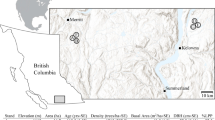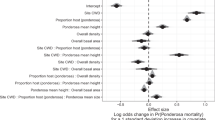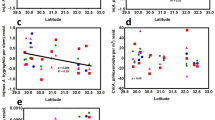Abstract
Context
Species distributions are influenced by how individuals interact with conspecifics, how they interact with other species, and by abiotic environmental factors. Resolving the nature of interspecific interactions using the relative spatial distributions of multiple species can therefore be considered an inverse problem.
Objective
We wished to determine whether defoliation by a lepidopteran (Choristoneura biennis [Freeman]) facilitates subsequent spruce beetle (Dendroctonus rufipennis [Kirby]) attack using spatiotemporal infestation patterns.
Methods
We used convergent cross mapping to probe time series of historical outbreaks of C. biennis and D. rufipennis in British Columbia, Canada, for evidence of interspecific interactions. We then fitted mixed model logistic regressions to spatial outbreak data to determine whether the probability of D. rufipennis infestation is impacted by prior defoliation by C. biennis.
Results
Convergent cross-mapping suggested that prior defoliation by C. biennis impacts D. rufipennis populations but this method cannot give information on the nature of the interaction. Our logistic regressions, however, provided insight into the nature of interactions by showing that the odds of moderate D. rufipennis infestation increased after moderate C. biennis infestation but decreased after severe C. biennis outbreaks. Thus, interactions between C. biennis and D. rufipennis are facilitative at moderate severities of C. biennis defoliation, but increasingly competitive as C. biennis outbreak severity increases.
Conclusions
Interactions between our study insects shifted from facilitative to competitive depending on outbreak severity—a proxy for population density. Density-dependent shifts from facilitation to competition are likely common in the animal kingdom.





Similar content being viewed by others
References
Agrawal AA, Sherriffs MF (2001) Induced plant resistance and susceptibility to late-season herbivores of wild radish. Ann Entomol Soc Am 94:71–75
Amin HS, Atkins PT, Russo RS, Brown AW, Sive B, Hallar AG, Hartz KEH (2012) Effect of bark beetle infestation on secondary organic aerosol precursor emissions. Environ Sci Technol 46:5696–5703
Amin HS, Russo RS, Sive B, Hoebeke ER, Dodson C, McCubbin IB, Hallar AG, Hartz KEH (2013) Monoterpene emissions form bark beetle infested Engelmann spruce trees. Atmos Environ 72:130–133
Aukema BH, Carroll AL, Zhu J, Raffa KF, Sickley TA, Taylor SW (2006) Landscape level analysis of mountain pine beetle in British Columbia, Canada: spatio temporal development and spatial synchrony within the present outbreak. Ecography 29:427–441
Barbier N, Couteron P, Lefever R (2008) Spatial decoupling of facilitation and competition at the origin of gapped vegetation patterns. Ecology 89:1521–1531
Bates D, Maechler M, Bolker B, Walker S (2013) lme4: Linear mixed effects models using Eigen and S4. R package version 1.0–5
Bentz BJ, Regniere J, Fettig CJ, Hansen EM, Hayes JL, Hicke JA, Kelsey RG, Negron JF, Seybold SJ (2010) Climate change and bark beetles of the Western United States and Canada. Bioscience 60:602–613
Bjørnstad ON (2013) ncf: spatial non-parametric covariance functions. R package version 1.1–5
Blodgett JJ, Eyles A, Bonello P (2007) Organ-dependent induction of systemic resistance and systemic susceptibility in Pinus nigra inoculated with Sphaeropsis sapinea and Diplodia scrobiculata. Tree Physiol 27:511–517
Borcard D, Legendre P, Avois-Jacquet et al (2004) Dissecting the spatial structure of ecological data at multiple scales. Ecology 85:1826–1832
Bowers WW, Borden JH, Raske A (1996) Incidence and impact of Polyphagus rufipennis (Coleoptera: Scolytidae) in Newfoundland. For Ecol Manag 89:173–187
Bruno JF, Stachowicz JJ, Bertness MD (2003) Inclusion of facilitation into ecological theory. Trends Ecol Evol 18:119–125
Cale WG, Henebry GM, Yeakly JA (1989) Inferring process from pattern in natural communities. Bioscience 39:600–606
Colgan LJ, Erbilgin N (2011) Tree-mediated interactions between the jack pine budworm and a mountain pine beetle fungal associate. Ecol Entomol 36:425–434
Coupé R, Stewart AC, Wikeem BM (1991) Engelmann spruce subalpine fir zone. In: Meidinger DV, Pojar J (eds) Ecosystems of British Columbia. British Columbia Ministry of Forests, Lands and Natural Resource Operations, Victoria, pp 223–236
Dickie IA, Schnitzer SA, Rech PB, Hobbie SE (2005) Spatially disjunct effects of co-occurring competition and facilitation. Ecol Lett 8:1191–1200
Erbilgin N, Colgan LJ (2012) Differential effects of plant ontogeny and damage type on phloem and foliage monoterpenes in jack pine (Pinus banksiana). Tree Physiol 32:946–957
Erbilgin N, Mori SR, Sun JH, Stein JD, Owen DR, Merrill LD, Bolanos RC, Raffa KF, Montiel TM, Wood DL, Gillette NE (2007) Response to host volatiles by native and introduced populations of Dendroctonus valens (Coleoptera: Curculionidae, Scolytinae) in North America and China. J Chem Ecol 33:131–146
Frye RH, Flake HW, Germain CJ (1974) Spruce beetle winter mortality resulting from record low temperatures in Arizona. Environ Entomol 3:752–754
Holsten EH, Their RW, Munson AS, Gibson KE (1999) The spruce beetle. For Insect Dis Leafl 127:11
Hutchinson MF (2011) ANUSPLIN Version 4.3 [online]. Centre for Resource and Environmental Studies, Australian National University. URL: http://fennerschool.anu.edu.au/publications/software/anusplin.php
Kaplan I, Denno RF (2007) Interspecific interaction in phytophagous insects revisited: a quantitative assessment of competition theory. Ecol Lett 10:977–994
Litvak ME, Monson RK (1998) Patterns of induced and constitutive monoterpene production in conifer needles in relation to insect herbivory. Oecologia 114:531–540
McIntire JB, Fajardo A (2009) Beyond description: the active and effective way to infer processes from spatial patterns. Ecology 90:46–56
McKenney DW, Hutchinson MF, Papadopol P (2011) Customized spatial climate models for North America. Bull Am Meteorol Soc 92:1611–1622
Meidinger DF, Pojar J, Harper WL (1991) Sub-boreal spruce zone. In: Meidinger DV, Pojar J (eds) Ecosystems of British Columbia. British Columbia Ministry of Forests, Lands, and Natural Resource Operations, Victoria, pp 209–222
Miller DR, Rabaglia RJ (2009) Ethanol and (−)-α-pineene: attractant kairomones for bark and ambrosia beetles in the Southeastern US. J Chem Ecol 35:435–448
Nealis KG, Turnquist R (2003) Predicting defoliation by Choristoneura biennis (Lepidoptera: Tortricidae). Can Entomol 135:903–907
Preisler HK, Hicke JA, Ager AA, Hayes JL (2012) Climate and weather influences on spatial temporal patterns of mountain pine beetle populations in Washington and Oregon. Ecology 93:2421–2434
R Development Core Team (2013) R: a language and environment for statistical computing. R Foundation for Statistical Computing, Vienna, Austria
Raffa KF, Krause SC, Reich PB (1998) Long-term effects of defoliation on red pine suitability to insects feeding on diverse plant tissues. Ecology 79:2352–2364
Rietkerk M, van de Koppel J (2007) Regular pattern formation in real ecosystems. Trends Ecol Evol 23:169–175
Schröder B, Seppelt R (2006) Analysis of pattern-process interaction based on landscape models—overview, general concepts and methodological issues. Ecol Mod 199:505–516
Silvertown J, Wilson JB (1994) Community structure in a desert perennial community. Ecology 75:409–417
Sugihara G, May R, Ye H, Hsieh CH, Deyle E, Fogarty M, Munch S (2012) Detecting causality in complex ecosystems. Science 338:496–500
Takens F (1981) Detecting strange attractors in turbulence. In: Rand DA, Young LS (eds) Dynamical systems and turbulence, Lecture notes in mathematics, vol 898, Springer, Berlin, pp 366–381
Turing AM (1952) The chemical basis of morphogenesis. Philos Trans B 237:37–72
Turner MG (1989) Landscape ecology: the effect of pattern on process. Annu Rev Ecol Syst 20:171–197
van de Koppel J, Rietkerk M, Danker N, Herman PMJ (2005) Scale-dependent feedback and regular spatial patterns in young muscle beds. Am Nat 165:E66–E77
van de Koppel J, Altieri AH, Silliman BR, Bruno JF, Bertness MD (2006) Scale-dependent interactions and community structure on cobble beaches. Ecol Lett 9:45–50
van de Koppel J, Gascoigne JC, Theraulaz G, Rietkerk M, Mooij WM, Herman PMJ (2008) Experimental evidence for spatial self-organization and its emergent effects in muscle bed ecosystems. Science 322:739–742
Velben KE (2008) Season and herbivore-dependent competition and facilitation in a semi-arid savanna. Ecology 89:1532–1540
Wright LC, Berryman AA, Wickman BE (1984) Abundance of the fir engraver, Scolytus ventralis, and the douglas fir beetle, Dendroctonus pseudotsugae, following tree defoliation by the douglas-fir Tussock Moth, Orgyia pseudotsugata. Can Entomol 116:293–305
Zhang Q, Alfaro RI (2002) Periodicity of two-year cycle spruce Budworm outbreaks in central British Columbia: a dendro-ecological analysis. For Sci 48:722–731
Zhang Q, Alfaro RI, Hebda RJ (1999) Dendroecological studies of tree growth, climate and spruce beetle outbreaks in central British Columbia, Canada. For Ecol Manag 121:215–225
Acknowledgments
We thank Tim Ebata of the BC Ministry of Forests, Lands and Natural Resource Operations, and GurpThandi of the Canadian Forest Service for access to maps of insect outbreaks in British Columbia. Thanks to Staffan Lindgren and Maya Evenden for proofreading and helpful comments. This study was completed as part of DWG’s doctoral work and funded by the National Sciences and Engineering Council of Canada (NSERC) which awarded a PGS-D2 scholarship to DWG and separate Discovery Grants to VJL and NE.
Author information
Authors and Affiliations
Corresponding author
Rights and permissions
About this article
Cite this article
Goodsman, D.W., Goodsman, J.S., McKenney, D.W. et al. Too much of a good thing: landscape-scale facilitation eventually turns into competition between a lepidopteran defoliator and a bark beetle. Landscape Ecol 30, 301–312 (2015). https://doi.org/10.1007/s10980-014-0139-3
Received:
Accepted:
Published:
Issue Date:
DOI: https://doi.org/10.1007/s10980-014-0139-3




